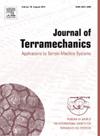Heavy-load variable stiffness lunar wheel based on adjustable tensegrity unit
IF 3.7
3区 工程技术
Q3 ENGINEERING, ENVIRONMENTAL
引用次数: 0
Abstract
Manned lunar landings have been prioritized as interstellar exploration capabilities continue to improve. Among them, the heavy-duty manned lunar rover is an essential tool for human lunar exploration. However, the lunar surface presents a highly complex and dynamic environment, rendering traditional lunar wheels inadequate for simultaneously addressing multifaceted requirements such as landing, locomotion, and vibration isolation. A heavy-load variable stiffness lunar wheel based on adjustable tensegrity unit is proposed, offering three stiffness states with a range of up to 178.25%. First, the wheel’s variable stiffness mechanism and corresponding applicable scenarios are introduced, along with the theoretical solution for vertical stiffness. Next, the static simulation using the finite element method (FEM) is performed to validate the theoretical solution. The lateral stiffness, impact tolerance, and single-point deformation capacity of the wheel are investigated. Results indicate that the current wheel addresses the limitations of traditional flexible lunar wheels with low lateral stiffness. Meanwhile, the wheel’s impact tolerance and single-point deformation capacity effectively meet the needs of rovers landing and operating on rugged terrains. Finally, a reduced-size prototype of the wheel is fabricated based on 3D printing technology, and the effectiveness of the variable stiffness mechanism is experimentally demonstrated.
基于可调张拉整体单元的重载变刚度月轮
随着星际探测能力的不断提高,载人登月已成为优先事项。其中,重型载人月球车是人类探月必不可少的工具。然而,月球表面呈现出高度复杂和动态的环境,使得传统的月球轮无法同时满足着陆、运动和隔振等多方面的要求。提出了一种基于可调张拉整体单元的重载变刚度月轮,提供了三种刚度状态,最大刚度范围为178.25%。首先,介绍了车轮变刚度机理及其应用场景,并给出了车轮垂直刚度的理论解。其次,利用有限元法进行了静力仿真,验证了理论解的正确性。研究了车轮的横向刚度、冲击公差和单点变形能力。结果表明,该车轮解决了传统柔性月球车轮侧向刚度低的局限性。同时,车轮的冲击容忍度和单点变形能力有效地满足了探测车在崎岖地形上着陆和运行的需要。最后,利用3D打印技术制作了缩小尺寸的车轮原型,并对变刚度机构的有效性进行了实验验证。
本文章由计算机程序翻译,如有差异,请以英文原文为准。
求助全文
约1分钟内获得全文
求助全文
来源期刊

Journal of Terramechanics
工程技术-工程:环境
CiteScore
5.90
自引率
8.30%
发文量
33
审稿时长
15.3 weeks
期刊介绍:
The Journal of Terramechanics is primarily devoted to scientific articles concerned with research, design, and equipment utilization in the field of terramechanics.
The Journal of Terramechanics is the leading international journal serving the multidisciplinary global off-road vehicle and soil working machinery industries, and related user community, governmental agencies and universities.
The Journal of Terramechanics provides a forum for those involved in research, development, design, innovation, testing, application and utilization of off-road vehicles and soil working machinery, and their sub-systems and components. The Journal presents a cross-section of technical papers, reviews, comments and discussions, and serves as a medium for recording recent progress in the field.
 求助内容:
求助内容: 应助结果提醒方式:
应助结果提醒方式:


